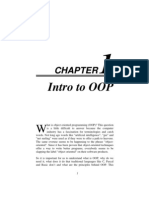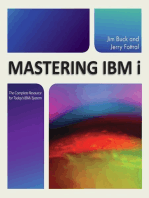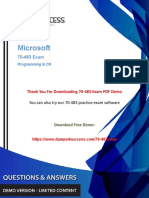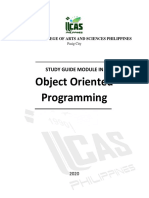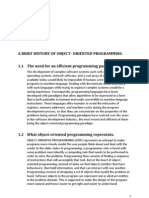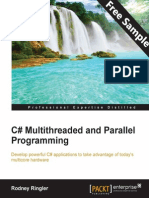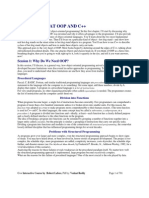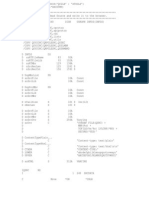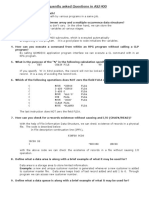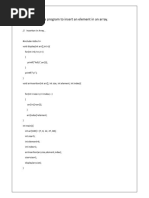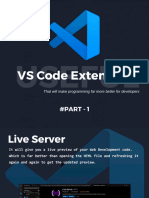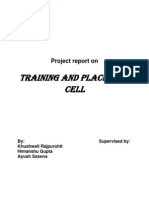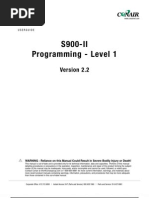Learning To Provide Modern Solutions: Providing Solutions To Meet Today's Industry Standards
Learning To Provide Modern Solutions: Providing Solutions To Meet Today's Industry Standards
Uploaded by
rachmat99Copyright:
Available Formats
Learning To Provide Modern Solutions: Providing Solutions To Meet Today's Industry Standards
Learning To Provide Modern Solutions: Providing Solutions To Meet Today's Industry Standards
Uploaded by
rachmat99Original Description:
Original Title
Copyright
Available Formats
Share this document
Did you find this document useful?
Is this content inappropriate?
Copyright:
Available Formats
Learning To Provide Modern Solutions: Providing Solutions To Meet Today's Industry Standards
Learning To Provide Modern Solutions: Providing Solutions To Meet Today's Industry Standards
Uploaded by
rachmat99Copyright:
Available Formats
1
Learning to Provide Modern Solutions
Over the course of this book, you will learn to enhance your existing applications to modernize the output of the system. To do this, well take advantage of the modern capabilities of ILE RPG that you can incorporate into your existing code. The Integrated Language Environment (ILE) enables you to write code in a much more modular way, which means you can write code in small, reusable components that are better encapsulated and easier to maintain.
Providing Solutions to Meet Todays Industry Standards
When you look at your Original Program Model (OPM) programs and think about why these programs were developed, the goal was likely to provide comprehensive software that would withstand the test of time and produce solid, reliable results as the backbone for business-critical operations. If you were to focus solely on this aspect, you might not see the need to even bother using ILE. After all, you have a programming language that works, it has been around for a very long time, and it is easy to understand. So, lets consider some of the limitations
11
CHAPTER 1: Learning to Provide Modern Solutions
of this way of programming and dene the reasons why modernization of the code is necessary. The rst thing that comes to mind when discussing modernization is aesthetics. When you have a system that provides indisputable data that is necessary for business processes, you may consider the ability to create modern reports in Microsoft Excel or Adobe PDF form as being an unnecessary enhancement. After all, the data is being generated, the information is being audited, reporting is being performed, and the company is generating revenue. How important is it to make the reports look better? Well, there are other factors beyond appearance that you need to consider when evaluating the need for spreadsheets and PDF les.
Portability
Portability is a big one. To address this issue, your initial thought might be to generate ASCII text les. If youve been working with RPG for a few years, theres a good chance youve already tried this approach. However, if you delimit the ASCII data using a special character, you must make the user aware of which delimiter youre using, and the user must process the data properly. This means you need specications that identify the elds and how they should be separated. In the end, the data is likely to be imported into an Excel spreadsheet anyway. When you provide an ASCII text le, you may have different formats for multiple records in the le. For example, you may have a header that displays a title and possibly user information that does not match the layout of the data, requiring you to identify when record formats change. There is also the issue of delivering the le to the users. Will you use a data transfer that must be dened for each user to download the correct physical le member? Will you use File Transfer Protocol (FTP) and require a user name and password?
12
Providing Solutions to Meet Todays Industry Standards
If you e-mail the text le, its carriage returns and line feeds might be altered during conversion through MIME format. Will you zip the le to avoid this issue, or will your e-mail application embed the text into the e-mail message and force the user to copy and paste the data from there? You could make the data available using a Web server, but if youre going to go that far, you might as well use HTML. The bottom line is that unless youre dealing with another programmer or a power user, you will likely encounter users who resist using ASCII text les, especially given the other options available today. PDF les are built specically to overcome these issues. With PDF les, all that users need is a reader, and they can view any PDF le without any of the preceding concerns. PDF readers are typically free and work on most operating systems. In fact, one is probably already installed with your OS. Even though PDFs are portable, they can be difcult to modify, which can be a good thing or a bad thing depending on your intentions. Microsoft Excel les offer the same portability as PDF les. A free viewer available from Microsoft lets users view these les in read-only mode. And with the availability of several open-source options, you can easily create and change such les using software that is supported on most operating systems.
Usability and Standardization
Another reason to provide electronic documents is usability. When you furnish data in an Excel spreadsheet, users can easily search and sort the data, creating ad hoc reports and performing what if scenarios. They can also create graphical representations of the data using charts and graphs. Last, Excel and PDF are two of the most commonly used types of data. Providing data in these standard formats makes the work of your users much easier to use and share with others.
13
CHAPTER 1: Learning to Provide Modern Solutions
Evolving Your RPG Development Skills
In the following chapters, well explore the evolution of RPG from OPM to ILE and discuss how to exploit the new capabilities of the IBM i platform. Our discussion is structured in a logical direction, rst building on your existing RPG coding skills by explaining the new features available in ILE and the new concepts involved with scoping and modular coding practices. Well start by converting some sample OPM source to an ILE-compatible format and implementing the use of the ILE compilers. With ILE, there are some new concepts to cover that involve the binding of components and the differences between an OPM program and an ILE program. The primary objective of the book is to integrate RPG with Java, so well focus our efforts on capabilities that directly lead us to this goal. Once we have the code in an ILE format, well begin to discuss procedures, service programs, and activation groups and why you may want to use them. For the purposes of this book, well look at how you can access Java objects and methods. Well discuss the denitions of objects and methods thoroughly in upcoming chapters. But on the simplest conceptual level, you can think of an object as being similar to a program that is called and put onto the call stack. It will be initiated to be contained in memory and will have variables initialized to specic values based on their data types. Java methods are similar to the subroutines that are available to a mainline program. Each subroutine has a specied name and function designed to make the subroutine a reusable resource to the mainline program. Java methods are actually more like procedures because they have clearly dened parameters one of the new ILE RPG capabilities well discuss. So, learning to use this new feature will also help you to understand Java methods when we get to that point.
14
Integrating RPG with Java
Developing Reusable Code
In our journey toward understanding the use of Java classes and methods from RPG, we will make every effort to encapsulate the Java interface into reusable code. When we do this, Ill go into a detailed analysis of how to interface with the Java environment, and Ill provide some RPG-friendly code that you can use in the future. I call these pieces of code RPG wrappers because well be wrapping RPG code around the Java classes and methods. You can make the RPG wrappers available to the program youre working with and then use pure RPG code to access the Java functionality. This technique not only makes the code easier for you to use in the future; you can also use it to perform all the exception handling, so you wont have to repeat the same code. This approach also lends more stability to your code because as you reuse the code, it will be exposed to more applications that employ it in different scenarios, ushing out any problems. This, in turn, will cause you to make the necessary changes to the code, which will then become more stable for the application in question and all the others that use it. When you start the next project, youll have some solid building blocks with which to begin. Once you have proven, reusable code components, you also will be able to reduce development time for subsequent projects and lessen maintenance support time because youll be using a smaller percentage of rst-time code. So, you win all around with the use of reusable code. Another benet to wrapping Java classes and methods in RPG is that you can easily share the new Java capabilities with your fellow RPG programmers in a form that they will be able to use immediately.
Integrating RPG with Java
Enhancing your RPG development skills is a great side effect of the primary objective of this book, which is to exploit the capabilities of Java from within RPG. When we get to that point, well explore all the new concepts you need to
15
CHAPTER 1: Learning to Provide Modern Solutions
understand about Java to get it to work properly. It would be nice if you could just plug in a Java method, as you can an application programming interface (API). But there are other things you need to think about when dealing with the Java Virtual Machine, such as starting and stopping it. And because two totally different environments are communicating with each other, you need to take some extra measures to handle some of the ugliness of reclaiming memory resources. Some of these topics may sound unappealing to you, and I agree. But fortunately, both IBM and Sun Microsystems have provided some useful code segments for dealing with these types of matters. So, what well do is create some handy procedures that will take care of most of these details for us, and well have to do minimal coding to support these issues. It took me quite a while to get through all these issues when I rst started. There were little pieces of information all over the place, and I had to discover the solutions as I stumbled through one frustrating setback after another. I hope to provide you with a much smoother transition into the world of Java than I had. I dont mean to sound discouraging. If anything, I intend just the opposite. My goal is to help you to easily overcome those obstacles and get you into production mode relatively quickly. As with the introduction of any new programming language, you will have to go through the growing pains of the initial learning curve. But a practical programming guide dramatically accelerates your ability to provide results quickly. And here we are! This book introduces you to the Java components necessary to provide the results youre looking for. It is not intended to teach you Java, but it does introduce you to Java and how to use specic parts of open-source technology to provide the product of your hard work, which in this case will be Excel spreadsheets and PDF les that you can distribute using e-mail from RPG.
16
Distributing Electronic Documents Using E-mail
Creating Electronic Documents
This is where the fun stuff starts to happen. You will learn a new skill in a real-world environment that will actually produce tangible results that are clearly visible to your users. Most of the time, new programming skills give you a greater knowledge base and better mechanics for your code development. But the latter sections of this book will give you the capability to hand over to your users a shiny new product that you know they will totally enjoy! This, in turn, will add much value to your software in the eyes of your users. If your objective is to provide reports that can be sorted, graphed, charted, and manipulated, you can convert your greenbar reports into an Excel spreadsheet. Well do this using the Horrible Spreadsheet Format (HSSF) capability of the POI open-source project. If your intention is to provide documents that can be distributed easily to users and customers in a portable format that anyone on any operating system can use, you may want to convert your greenbar reports, billing invoices, or labels and bar codes to the PDF format. Well use the iText open-source project to provide these capabilities. Well accomplish these objectives by rst dening the technical terms and concepts of the components that make up an electronic document and relating them to the Java classes and methods available in POI and iText. Then, well convert the methods and parameters into an RPG-friendly format and build wrappers for them. After that, you can start using them from within RPG. Sounds simple enough!
Distributing Electronic Documents Using E-mail
Once you have a program that generates electronic documents, youll need to decide how youre going to get the end results to your users. My rst step was to put the electronic documents onto a publicly accessible network drive. This solution was okay when I rst got started with a few users. But my user base quickly grew, and certain reports needed to be visible only to specic users, and it just
17
CHAPTER 1: Learning to Provide Modern Solutions
got out of control from there. Users were starting to archive their reports on the network drive and calling the IT support line about les they were seeking. As the number of les grew, the amount of time required to perform backups grew as well, requiring more administration than I had bargained for. So, I soon decided to accommodate these requirements using an automated e-mail system. This approach allowed the distribution lists to be changed to send only to particular users, gave users the option to save or delete the les, and did not require users to have a network drive mapped. It also made it possible to easily send the reports to customers who didnt have access to the network. When evaluating the options to provide my IBM i system with e-mail capability, I found JavaMail to be the most self-contained and exible solution. Using JavaMail, we will build an e-mail client that simply creates the e-mail and relays it through your current e-mail server no additional servers or conguration required. Well start with a simple text e-mail, specifying the to, from, and subject, and then advance to formatted e-mails containing HTML and attachments. You can even embed the images right into the e-mail, if desired. Using JavaMail for your e-mail client frees you from being tied to the operating system. Once you understand the JavaMail API and you start using Java, youll be able to easily rewrite your RPG program into pure Java and use the exact same API to provide the same capability to any other server on the network. This freedom and knowledge will also help you as a programmer to begin to integrate with other areas of technology in your company and will give you greater exibility, not only in your programming options but as a valued member of the programming team. And thats just the beginning! In addition to giving you the isolated capabilities of the service programs well discuss, Ill walk you through the process of identifying and implementing the classes and methods. So, once you get your RPG programs to start generating electronic documents and sending e-mails, you can further explore other options that are available and expand your service programs to implement more and more features. I hope this will be the beginning of a whole new level of programming using Java for you. Lets get started.
18
You might also like
- Parallel Computing For Data Science With Examples in R, C++ and CUDA (PDFDrive)Document336 pagesParallel Computing For Data Science With Examples in R, C++ and CUDA (PDFDrive)jeremy mahNo ratings yet
- Let Us C++Document14 pagesLet Us C++tameshh43% (7)
- Python Programming For Beginners: Learn The Basics Of Python Programming (Python Crash Course, Programming for Dummies)From EverandPython Programming For Beginners: Learn The Basics Of Python Programming (Python Crash Course, Programming for Dummies)Rating: 5 out of 5 stars5/5 (1)
- Applying SOA Principles in Informatica - Keshav VadrevuDocument91 pagesApplying SOA Principles in Informatica - Keshav VadrevuZakir ChowdhuryNo ratings yet
- Mastering IBM i: The Complete Resource for Today's IBM i SystemFrom EverandMastering IBM i: The Complete Resource for Today's IBM i SystemRating: 3 out of 5 stars3/5 (1)
- (Updated 2018) 70-483 Dumps - Microsoft Programming in C# Exam Questions PDFDocument24 pages(Updated 2018) 70-483 Dumps - Microsoft Programming in C# Exam Questions PDFMuzammil Abbas100% (4)
- Full Project LibraryDocument77 pagesFull Project LibraryMohammed Jibril78% (9)
- Mastering PhoneGap Mobile Application Development - Sample ChapterDocument46 pagesMastering PhoneGap Mobile Application Development - Sample ChapterPackt PublishingNo ratings yet
- DEVASCDocument667 pagesDEVASCAmil AkhundzadaNo ratings yet
- IT 107 Object Oriented ProgrammingDocument25 pagesIT 107 Object Oriented ProgrammingAriana MilesNo ratings yet
- python presentation 1Document3 pagespython presentation 1Pranav reddy NaniNo ratings yet
- Node - Js High Performance - Sample ChapterDocument17 pagesNode - Js High Performance - Sample ChapterPackt PublishingNo ratings yet
- Swepna Netbeans ProjectDocument14 pagesSwepna Netbeans ProjectShalu OjhaNo ratings yet
- Reading Writing Articles FinalDocument8 pagesReading Writing Articles Finaldangabrieldeyro1No ratings yet
- Homework 3.1 Mongodb JavaDocument8 pagesHomework 3.1 Mongodb Javaafmtbioei100% (1)
- Thesis 184 WordpressDocument7 pagesThesis 184 WordpressHelpMeWithMyPaperCanada100% (2)
- Extending SaltStack - Sample ChapterDocument15 pagesExtending SaltStack - Sample ChapterPackt PublishingNo ratings yet
- Functional Design and Architecture MEAP V09 Alexander Granin 2024 Scribd DownloadDocument65 pagesFunctional Design and Architecture MEAP V09 Alexander Granin 2024 Scribd Downloadbijimesavioz100% (2)
- Java for Beginners: A Crash Course to Learn Java Programming in 1 WeekFrom EverandJava for Beginners: A Crash Course to Learn Java Programming in 1 WeekRating: 5 out of 5 stars5/5 (1)
- Discovering The Value of IBM API Connect: Firmware Version: 5.0.0.1Document137 pagesDiscovering The Value of IBM API Connect: Firmware Version: 5.0.0.1Manish GuptaNo ratings yet
- Learning Dart Sample ChapterDocument39 pagesLearning Dart Sample ChapterPackt PublishingNo ratings yet
- OOP Lecture 1Document22 pagesOOP Lecture 1sawairaamjad197No ratings yet
- Mastering Google App Engine - Sample ChapterDocument32 pagesMastering Google App Engine - Sample ChapterPackt PublishingNo ratings yet
- 7 Ways To Write Cleaner, More Effective CodeDocument5 pages7 Ways To Write Cleaner, More Effective CodeJuan Manuel Antón Bernal100% (1)
- Object - Oriented Programming - JavaDocument25 pagesObject - Oriented Programming - JavaSamuel-Moyin OjuriNo ratings yet
- Unit 1 Object Orinted ProgrammingDocument10 pagesUnit 1 Object Orinted Programmingdaya gautamNo ratings yet
- Module 1 - Emerging TrendsDocument20 pagesModule 1 - Emerging TrendsLawrence Corpus AducaNo ratings yet
- Learning Dart - Second Edition - Sample ChapterDocument30 pagesLearning Dart - Second Edition - Sample ChapterPackt Publishing100% (2)
- C# Multithreaded and Parallel Programming Sample ChapterDocument36 pagesC# Multithreaded and Parallel Programming Sample ChapterPackt PublishingNo ratings yet
- LangChainJS For Beginners - Nathan SebhastianDocument168 pagesLangChainJS For Beginners - Nathan Sebhastiankodaneb161No ratings yet
- Mongodb Homework 3.1 PythonDocument6 pagesMongodb Homework 3.1 Pythonafmtkadub100% (1)
- Mongodb For Node - Js Developers Homework 3.1Document7 pagesMongodb For Node - Js Developers Homework 3.1erjdrh34100% (1)
- Functional Programming in Go: Apply functional techniques in Golang to improve the testability, readability, and security of your codeFrom EverandFunctional Programming in Go: Apply functional techniques in Golang to improve the testability, readability, and security of your codeNo ratings yet
- All About Backend DevelopmentDocument9 pagesAll About Backend DevelopmentSyeda AnmolNo ratings yet
- Java Crash CDocument181 pagesJava Crash CLincolnNo ratings yet
- Uml ThesisDocument8 pagesUml Thesisybkpdsgig100% (1)
- Student Lab Guide - IBM API Connect Proof of Technology v5.0.1.0Document134 pagesStudent Lab Guide - IBM API Connect Proof of Technology v5.0.1.0narendar10100% (1)
- OopusingcDocument9 pagesOopusingcapi-213911742No ratings yet
- Delphi High Performance: Master the art of concurrency, parallel programming, and memory management to build fast Delphi appsFrom EverandDelphi High Performance: Master the art of concurrency, parallel programming, and memory management to build fast Delphi appsNo ratings yet
- Functional Design and Architecture MEAP V09 Alexander Granin 2024 Scribd DownloadDocument50 pagesFunctional Design and Architecture MEAP V09 Alexander Granin 2024 Scribd Downloadbxbyyoyer100% (4)
- Mongodb DBA Homework 4.3 AnswerDocument6 pagesMongodb DBA Homework 4.3 Answerafmtoolap100% (1)
- Lesson 6 - Putting Layers Together With A Web Mapping APIDocument15 pagesLesson 6 - Putting Layers Together With A Web Mapping APIrokomNo ratings yet
- Concept of OppDocument8 pagesConcept of OppralragobiNo ratings yet
- Java IntroDocument53 pagesJava IntroHise WiseNo ratings yet
- Transcription Course 2Document11 pagesTranscription Course 221108186mlNo ratings yet
- Functional Programming in Scala, Second Edition (MEAP V08) Michael Pilquist All Chapters Instant DownloadDocument27 pagesFunctional Programming in Scala, Second Edition (MEAP V08) Michael Pilquist All Chapters Instant Downloadmalisemutari100% (1)
- ERP Lab Manual - 1Document27 pagesERP Lab Manual - 1rohanNo ratings yet
- Implementing C# 11 and .NET 7.0: Learn how to build cross-platform apps with .NET Core (English Edition)From EverandImplementing C# 11 and .NET 7.0: Learn how to build cross-platform apps with .NET Core (English Edition)No ratings yet
- Andrew Treadway - Software Engineering For Data Scientists (MEAP V03) - Manning Publications (2023)Document319 pagesAndrew Treadway - Software Engineering For Data Scientists (MEAP V03) - Manning Publications (2023)Erick Costa De FariasNo ratings yet
- Ninja With A BookDocument31 pagesNinja With A BookWilson GayoNo ratings yet
- C++ Robert LaforeDocument701 pagesC++ Robert LaforeUsman Waheed100% (3)
- C# Part 1Document30 pagesC# Part 1James DaumarNo ratings yet
- LangChain for JavaScript Developers How to Integrate LLMs Into Javascript Web Apps (Daniel Nastase) (Z-Library)Document120 pagesLangChain for JavaScript Developers How to Integrate LLMs Into Javascript Web Apps (Daniel Nastase) (Z-Library)wolvskyNo ratings yet
- Mongodb Homework 4.2 AnswerDocument4 pagesMongodb Homework 4.2 Answerh3tdfrzv100% (1)
- Building A Web Store With Struts & ADF FrameworksDocument132 pagesBuilding A Web Store With Struts & ADF Frameworksapi-3771999100% (1)
- Meteor Design Patterns - Sample ChapterDocument31 pagesMeteor Design Patterns - Sample ChapterPackt PublishingNo ratings yet
- A Bridge Between Engineering and MathematicsDocument2 pagesA Bridge Between Engineering and Mathematicsrachmat99No ratings yet
- Pivot TablesDocument18 pagesPivot TablesAdil Akbar JanjuaNo ratings yet
- The Blue Book of ChessDocument264 pagesThe Blue Book of Chessrachmat99No ratings yet
- Chess NotationDocument9 pagesChess Notationrachmat99No ratings yet
- Prototypes For RPG IV ApisDocument10 pagesPrototypes For RPG IV Apisrachmat99No ratings yet
- Int 1Document48 pagesInt 1rachmat99No ratings yet
- Send File Using FTP (CPP)Document13 pagesSend File Using FTP (CPP)rachmat99No ratings yet
- Read Source and Write It To The BrowserDocument5 pagesRead Source and Write It To The Browserrachmat99No ratings yet
- InstructDocument3 pagesInstructrachmat990% (1)
- The Blue Book of ChessDocument264 pagesThe Blue Book of Chessrachmat99No ratings yet
- As 400 Subfile Programming Part II Basic CodingDocument13 pagesAs 400 Subfile Programming Part II Basic Codingrachmat99No ratings yet
- Embedded SQL and Dynamic Sorting SubfilesDocument17 pagesEmbedded SQL and Dynamic Sorting Subfilesrachmat99No ratings yet
- Who Removed My Registered Exit ProgramDocument3 pagesWho Removed My Registered Exit Programrachmat99No ratings yet
- Profile: Enis Gemil: Personal DataDocument4 pagesProfile: Enis Gemil: Personal DataEnis GemilNo ratings yet
- Frequently Asked Questions in AS/400Document61 pagesFrequently Asked Questions in AS/400VivianNo ratings yet
- De La Salle University-Manila Gokongwei College of EngineeringDocument5 pagesDe La Salle University-Manila Gokongwei College of EngineeringAlyssa Beatrice CuevoNo ratings yet
- Practical DSUCDocument6 pagesPractical DSUCrkumargupta205No ratings yet
- Complete SQL QueriesDocument61 pagesComplete SQL Queriesshivi08100% (1)
- Frequently Asked Questions - AVRDocument18 pagesFrequently Asked Questions - AVRSagar Gupta100% (2)
- Overview of Next-Generation Java Frameworks (2022)Document1 pageOverview of Next-Generation Java Frameworks (2022)pbecicNo ratings yet
- 11wi Midterm SolutionDocument8 pages11wi Midterm SolutionHillary NthomeNo ratings yet
- VS Code ExtensionsDocument8 pagesVS Code Extensionsdiwakar singhNo ratings yet
- Algorithm and FlowchartingDocument3 pagesAlgorithm and FlowchartingOwene Miles AguinaldoNo ratings yet
- Training and PlacementDocument49 pagesTraining and PlacementHimanshu Gupta88% (65)
- The Operating System Is The Most Important Program That Runs On A ComputerDocument4 pagesThe Operating System Is The Most Important Program That Runs On A ComputersnobarhussainNo ratings yet
- Cycle test 1 ADSADocument1 pageCycle test 1 ADSAprathy1018No ratings yet
- Instruction Set of 8086 MicroprocessorDocument95 pagesInstruction Set of 8086 MicroprocessorRavindra MahajanNo ratings yet
- VBAPrimerDocument16 pagesVBAPrimerg.talebiNo ratings yet
- S900II Programming Level I V21Document82 pagesS900II Programming Level I V21Francisco Macias100% (1)
- Bank - ManagementDocument14 pagesBank - Managementfopovi6610No ratings yet
- Javascript FunctionDocument15 pagesJavascript FunctionimannurumairahNo ratings yet
- Tutorial I5 - IsightAbaqus-DataMatchingDocument13 pagesTutorial I5 - IsightAbaqus-DataMatchingAna MartinezNo ratings yet
- BCA Final Year Project - Ecommerce SiteDocument63 pagesBCA Final Year Project - Ecommerce SiteMayil Raj Subramanian100% (1)
- User Guide: AVEVA User Documentation 12 SeriesDocument79 pagesUser Guide: AVEVA User Documentation 12 SeriesRancang PersadaNo ratings yet
- AssignmentsDocument2 pagesAssignmentsMoviez kingNo ratings yet
- PDF Advanced Programming ModuleDocument50 pagesPDF Advanced Programming ModuleShrutiNo ratings yet
- Lineland - HBase Architecture 101 - StorageDocument15 pagesLineland - HBase Architecture 101 - StorageAmir RiazNo ratings yet
- Union With Outer and Inner JoinDocument1 pageUnion With Outer and Inner JointopankajsharmaNo ratings yet
- Week - 5 (Deep Learning) Q. 1) Explain The Architecture of Feed Forward Neural Network or Multilayer Perceptron. (12 Marks)Document7 pagesWeek - 5 (Deep Learning) Q. 1) Explain The Architecture of Feed Forward Neural Network or Multilayer Perceptron. (12 Marks)Mrunal BhilareNo ratings yet
- Jfym Book Huduma Ya Vijana SwahiliDocument5 pagesJfym Book Huduma Ya Vijana SwahiliBOAZ MEDIANo ratings yet

